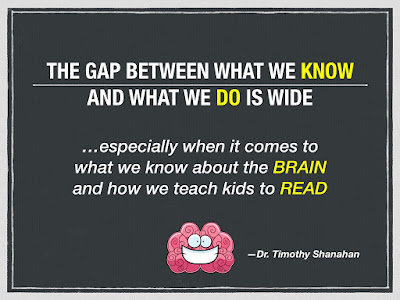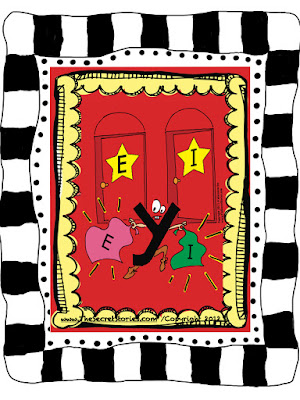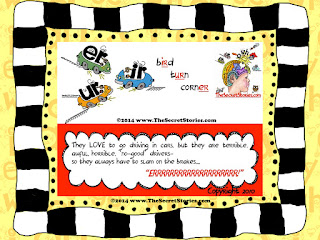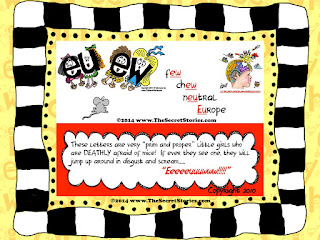 |
| Breaking Down the Grade Level Walls that Limit Early Learner Access to the Code! |
Dear Katie
I love reading your blog! I've used your free Zoo Keeper Writing Strategies with my kinder class and the children really related, always showing me “how many animals (i.e. sounds) they caught" in their words!
I've taught both 1st and 2nd grades for years, and now am in my seventh year of teaching kindergarten. As many of your letter pattern stories are, of course, geared toward 1st and 2nd, I was wondering if you had some that were more geared more toward kinder?
Also, at what point would you begin introducing the Secret Stories in kinder... after the majority know most of their letters?
You are such an inspiration—Thank you!
Gratefully,
Marian M.
Kindergarten Teacher
(Download the Free Zoo Keeper Strategy Pack and watch this video clip to see how it works!)
"Zoo Keeper and M&M Quizzes" for Early Grade Writing!
I love Marian's question, as it goes right to the heart of why I created the Secret Stories® in the first place, which was to break down the grade level walls of skill introduction that limit early learner-access to the code!
Before I answer it specifically, I want to prepare you for the paradigm shift we're about to take when it comes to what kindergarten can do and when they can do it, and I think these links will help! So here are a couple of guest posts by kindergarten teacher, Kjersti Johnson (post 1 and post 2) along with a couple of eye-opening, kindergarten-related video clips here and here.
Before I answer it specifically, I want to prepare you for the paradigm shift we're about to take when it comes to what kindergarten can do and when they can do it, and I think these links will help! So here are a couple of guest posts by kindergarten teacher, Kjersti Johnson (post 1 and post 2) along with a couple of eye-opening, kindergarten-related video clips here and here.
So let's get started by opening up a can of worms about WHY we do WHAT we do WHEN we do it when it comes to the "code" that kids need for reading and writing!
If you really think about it, what are kids supposed to do with just bits and pieces of the reading and writing code? How can you read OR write about your pet mouse with only a third, or even two-thirds of the code? And that's all most early grade level learners have to work with, given that it takes multiple grade level years to teach it all.... and that's if they're on grade level!
The individual letter sounds (which kindergartners spend an entire year learning) provide very little bang for the buck when it comes to using them to reading and writing, as they are actually the least likely sounds that the letters will make when they get together in real words! This makes the brain's job as a "pattern-making" machine extremely difficult, as it seems that letters are never actually doing what they're supposed to!
And simply adding the blends and a few digraphs to the mix in first grade doesn't help all that much, which is why kindergartners and first graders can barely read or write anything! At least not anything that hasn't been "memorized" (ENTER SIGHT WORDS, STAGE RIGHT!)
Moreover, the less skills kids bring to the table, the less value they take away from daily reading and writing experiences (er, um...I meant to say, "word calling" and "word copying" experiences—Lol!)
Imagine you're a Morse Code operator just assigned to a naval ship.
But there's a problem.
You are only in the first year of a three year Morse Code training program, which means that you barely know even one-third of the code. Yet you are expected to send and receive messages on day one.
You think to yourself......
"How can I possibly be expected to accurately send and receive messages with not even one-third of the code? What about all of the sounds I haven't learned yet? How will I be able to figure out what the incoming messages say? And worse still, how can I send messages if I don't know the code for all of the words? Should I just leave those parts blank, or just fill up the page with the parts of the code that I do know? Or maybe I could just forgo what the captain wants me to send and just "write what I can spell" instead?
These are common strategies that beginning (and struggling) learners will also use in order to get around all of the parts of the code that they don't know or haven't yet been taught— of which there are many!
A scope and sequence cannot accurately predict which parts of the code learners will need to read their favorite book or to write the stories they want to tell. The th digraph is considered a 1st grade skill by grade level scope and sequence standards, even though th can be found on every line of every page in every book! In fact, kindergartners will encounter the th pattern literally hundreds of times on their very first day! (And don't even get me started on the letter y!) The bottom line is that just like with Morse Code, you need ALL of it to do ANYTHING with it!
So the burning question is how to provide our earliest grade level learners with access to the "whole" code when it takes an entire for many kids to just learn the alphabet? The answer lies in the brain science.
Brain science lights a path straight through the brain's backdoor via the earlier developing, social and emotional "feeling" networks. By targeting phonics instruction to the affective learning domain, we can bypass areas of inherent early (and struggling) learner weakness (i.e. the higher level, executive processing centers) and tap into alternative areas of strength.
Secret Stories® does this in a variety of ways, beginning with channeling the individual letters and sounds through muscle memory (i.e. body intelligence) for accelerated mastery in just two weeks to two months— and that's for kinder and PK! (And we're not just talking the "basic" letter sounds, we're talking every possible sound that a letter can make by itself, from hard and soft c and g, to the long and short vowel sounds, to the positional sounds of y, and even qu.... and all while they eat their shoes and lick the carpet. (And if you actually teach preK or kinder, then you understand exactly what I mean— Lol!)
During the two week-two month time frame while the individual letter sounds are seeping in via muscle memory, they are also learning about the letters' Secrets, (i.e. Secret Stories®) which are what they do when they don't do what they should! The Secrets explain all of the crazy sounds that letters make when they get together, and even some of the strange things they can do when they are by themselves!
Shared as short little stories that are easy to remember and understand, they are ready for immediate use in both reading and writing! And because Secret Stories® aligns letter behavior to learners' own behavior (by way of already familiar "social and emotional" frameworks) they can easily predict their most and next most likely sound behaviors, just as they could predict the behavior of their own classmates.
The individual letter sounds (which kindergartners spend an entire year learning) provide very little bang for the buck when it comes to using them to reading and writing, as they are actually the least likely sounds that the letters will make when they get together in real words! This makes the brain's job as a "pattern-making" machine extremely difficult, as it seems that letters are never actually doing what they're supposed to!
And simply adding the blends and a few digraphs to the mix in first grade doesn't help all that much, which is why kindergartners and first graders can barely read or write anything! At least not anything that hasn't been "memorized" (ENTER SIGHT WORDS, STAGE RIGHT!)
 |
| The Sight Word Epidemic |
And the sight word-parade begins...
Sight words are the "go-to" teacher tool to compensate for a beginning reader's gross lack of phonics skills and meet the required text-level assessment. Sight words are more of a necessity, rather than a choice when you consider that phonics skills are only divvied-out in small bits and pieces— from PreK to 2nd— which leaves kinder in the worst boat of all. As my friend Dr. Richard Allington says, "Three to four grade level years is just too long to make learners wait for the whole code."
But while teaching kids to memorize words instead of actually reading them might feel like a necessity for kinder and first grade students to meet the required text level assessments, is far from the ideal, both developmentally and from a brain-based perspective. (You can read more about this here or by clicking the link under the picture below.)
 |
| Why Kids Shouldn't Memorize What They Could READ! |
Imagine you're a Morse Code operator just assigned to a naval ship.
But there's a problem.
You are only in the first year of a three year Morse Code training program, which means that you barely know even one-third of the code. Yet you are expected to send and receive messages on day one.
You think to yourself......
"How can I possibly be expected to accurately send and receive messages with not even one-third of the code? What about all of the sounds I haven't learned yet? How will I be able to figure out what the incoming messages say? And worse still, how can I send messages if I don't know the code for all of the words? Should I just leave those parts blank, or just fill up the page with the parts of the code that I do know? Or maybe I could just forgo what the captain wants me to send and just "write what I can spell" instead?
Dear Captain,
I like the sub. It is big. It is fun. It is really fun.
I like it so so much. I really really like the big fun sub a lot!
I like it so so much. I really really like the big fun sub a lot!
These are common strategies that beginning (and struggling) learners will also use in order to get around all of the parts of the code that they don't know or haven't yet been taught— of which there are many!
A scope and sequence cannot accurately predict which parts of the code learners will need to read their favorite book or to write the stories they want to tell. The th digraph is considered a 1st grade skill by grade level scope and sequence standards, even though th can be found on every line of every page in every book! In fact, kindergartners will encounter the th pattern literally hundreds of times on their very first day! (And don't even get me started on the letter y!) The bottom line is that just like with Morse Code, you need ALL of it to do ANYTHING with it!
 |
| Click here to learn more |
Brain science lights a path straight through the brain's backdoor via the earlier developing, social and emotional "feeling" networks. By targeting phonics instruction to the affective learning domain, we can bypass areas of inherent early (and struggling) learner weakness (i.e. the higher level, executive processing centers) and tap into alternative areas of strength.
Secret Stories® does this in a variety of ways, beginning with channeling the individual letters and sounds through muscle memory (i.e. body intelligence) for accelerated mastery in just two weeks to two months— and that's for kinder and PK! (And we're not just talking the "basic" letter sounds, we're talking every possible sound that a letter can make by itself, from hard and soft c and g, to the long and short vowel sounds, to the positional sounds of y, and even qu.... and all while they eat their shoes and lick the carpet. (And if you actually teach preK or kinder, then you understand exactly what I mean— Lol!)
Individual Letter Sound Mastery in 2 weeks to 2 months!
Shared as short little stories that are easy to remember and understand, they are ready for immediate use in both reading and writing! And because Secret Stories® aligns letter behavior to learners' own behavior (by way of already familiar "social and emotional" frameworks) they can easily predict their most and next most likely sound behaviors, just as they could predict the behavior of their own classmates.
 |
| Download the Free Secret Stories® Mini-Poster Sample Pack! |
Our brains thrive on patterns and making things make sense, and the Secrets make letters make sense!And the earlier the grade level, the MORE they are needed, as they have virtually nothing else to read or write with! Kinder will naturally pick up and remember the Secrets BEFORE all of the individual letter sounds have taken hold, as the time frame for muscle memory to kick in is between two weeks to two months, whereas the Secrets are instant! Stories are easy for kids to remember because stories are HOW kids remember! And stories are developmentally harmless, so when they are ready to plug it in and use it, they can... but until that time, it's simply a story!
Shifting early grade reading instruction from brain-antagonistic to brain-compatible requires that we FEED the brain, not FIGHT it, and Secret Stories® are its favorite treat! They can (and should!) be given all day long, throughout the entire instructional day— anytime and anywhere they are needed to help read or spell a word. Every Secret you give them is one more "tool" in their tool belt that they can bring to the reading and writing table, so as to bring more value away!
So to answer Marian's questions...
The Secrets are not bound by the traditional "grade level walls" of grade level instruction that limit learner-access to the code. To share only certain Secrets at certain grade levels would presume that learners at lower grade levels don't need them, and how could that be true if they are reading and writing across the instructional day beginning in kindergarten? Nor can we possibly say WHICH Secrets a learner will need to read the book he picks from the library or to write a word in a story he wants to tell.Like the Morse Code operators, they need ALL of the code!
So NEVER wait to share a Secret!
Share them simultaneously with the individual letter sounds, whenever and wherever they are needed, whether it's on the morning calendar or on the lunch menu! Remember that to a Morse Code operator (or to a beginning reader/writer) a th is going to come in a LOT more handy than a t, so never hold back the tools that you know kids need to read and write every day!
Why should we wait? Why hold back what kids so desperately need every hour of every day in our classrooms when they are working with text? If the brain science provides a "secret" backdoor passage through which we can so easily sneak phonics skills, why wouldn't we use it?
 |
| A "Backdoor Delivery System" for Accelerated Skill Access |
Until Next Time,
Katie Garner :-)
 |
Never Miss a Secret! Subscribe to the Newsletter! |
 | |||
|























Looking forward to hearing how they do!
Julie
lorepuckett at gmail dot com
Folks were setting chairs out on both ends of the corridor to hear you, but unfortunately my ears are too old to hear from that far away so I gave up! I'm hoping to have better luck seeing you at the Natl Elementary Principals Conference this summer.
You should know that your 'Secrets' are an ongoing topic of conversation at our school and have had an incredible impact on our student achievement this year. As a school administrator, it's been truly amazing to witness the progress made at each grade level, especially by our most at-risk. I'm just in awe, as are our parents (which is always a good thing!)
My teachers were so disappointed that I couldn't get into your session, as they promised the kids that I would take a picture with you to show them. Apparently the teachers that came to your sessions last year tried, but it was too crowded and you had too many people around you afterwards. I told them that this year was even worse, given that I couldn't even get through the door!
Hopefully I'll have better luck seeing you in July!
I will most definitely be at the Principal's Conference in July and I'll even save a seat for you, just in case ;)
Thanks for your kind email, and please let your teachers (and students) know how happy I am to hear of their progress (and we'll definitely take that picture, as well!)
Looking forward to meeting you in July,
Katie
I am gearing up to make the next set before I have to leave town again for conference, with the focus being on "What to do when a "Secret" doesn't work?!!" as that's actually where the fun begins for learners with regard to their daily interactions with text becoming a virtual "playground" for critical thinking!!
In the meantime, don't hesitate to ask, should you have any questions, and thanks again for your comment!
I remember wanting to buy my whole class t-shirts with- "I survived Mrs. Garner's 1st Year Teaching!!" written across the front!! ;)
These 'work-around' strategies (i.e. motor/ muscle memory for individual letters and sounds; social/ emotive connections/ cues for complex pattern sound retrieval) are crucial for learners struggling with cognitive readiness.
For these learners, in particular, the ability to GIVE these core reading and writing skills, rather than having to wait on 'developmental readiness' in order to TEACH them, truly makes all the difference!!
So many of the problems that Title I learners face stem from the fact that in the first few years of school, they are 'slaves' to their own developmental readiness, resulting in their having to continually play on an uneven playing field!
By using brain research findings to circumvent these pitfalls, we can actually avoid these deficit areas in the brain entirely, targeting the stronger, more capable areas instead!
(Hope this makes sense.... have had glass of wine!!! :)
I am so glad to view your videos and your updates here. I learn something new everytime. Thanks so much !
Denise
I'm so glad you found the videos and updated info on the Secret Stories website, as I've really been working hard to 'flesh-out' the basic strategy-base.
I'm curious if you've been in the same grade level since you started using them or if you've moved around a bit?
My best teacher friend went to your workshop ...she was so impressed, she came back and told me all about this great new program. I was so excited I purchased the set with my own money and have been using it ever since.
(and by useful, I mean 'only what's necessary to be able to read and write,' given that the goal is to give learners at the earliest grade level EVERYTHING they need to jump into working with text.... both reading and writing!!
Because the brain will require an explanation for anything encountered on a fairly frequent basis in text- there could be 'no stone left unturned' when it comes to accounting for the various letter patter sound possibilities. This, however, is different from teaching "rules for rules' sake" (i.e. the less useful and/ or less frequently occurring phonics rules/ sound patterns).
My rule of thumb was to account for only those patterns/ sounds that occurred '5 times or more' in text, given their likelihood to be encountered often enough by learners to require an explanation.
Patterns/ sounds occurring LESS than five times would are either put in "Word Jail" OR 'rehabilitated' .... so as to avoid having an 'overcrowded prison system' / overcrowded word wall, both of which are equally ineffective ;)
As for your specific question regarding the letter a and providing the 'uh' or 'schwa sound' being taught/ included in the "Better Alphabet Song" as an additional sound option.... this would be an example having 'too many cooks in the kitchen,' in that there is too little value/ purpose in teaching it.
What I mean by this is, if a beginning learner knows the SECRETS, he will attack a word like 'about' or 'around' with a 'short a' sound, as he knows that Mommy e isn't 'one letter away' and thus can't make a 'say its name.' Attacking these words with the short a sound will STILL result in learners (even lower level Kindergartners!!) still being able to 'get the word.' In other words, they will still recognize that the word is 'about' or 'around,' regardless of the fact that they attacked it with the short a sound ...... The presumption is that learners can and will apply at least a "grain of common sense" in recognizing the word, and my experience with the 'lowest of the low' kindergartners proves this out!!
By taking into account the differences between how words can sound, depending upon how they are sounded out, I was able to determine which required SECRETS and which were, for lack of a better term...."figure-out-able!!" LoL!
With the Sneaky Y, all THREE sounds had to be accounted for, as they are all vastly different (y as in yellow, y as in July, and y as in mommy) ..... Each are entirely different sounds and thus, each must be accounted for with logical explanations as to what / why causes each to occur.
Again, with the ultimate goal being to GIVE learners EVERYTHING they need to read and write at the EARLIEST grade level, so as to allow EXPERIENCE to be the best teacher..... it was necessary to think in terms of training "ER Doctors" ..... preparing them for what's 'most likely' to roll through the door, while spending less time preparing them to handle the "plague" ;)
I hope this helps to clarify the basis for the SECRETS, and I promise to get into more detail about exactly this in upcoming posts.... you're just one step ahead with your great question!!!!
Jada
jadawtolbert@gmail.com
as the "WHY" equals "CRITICAL-THINKING!"
:)